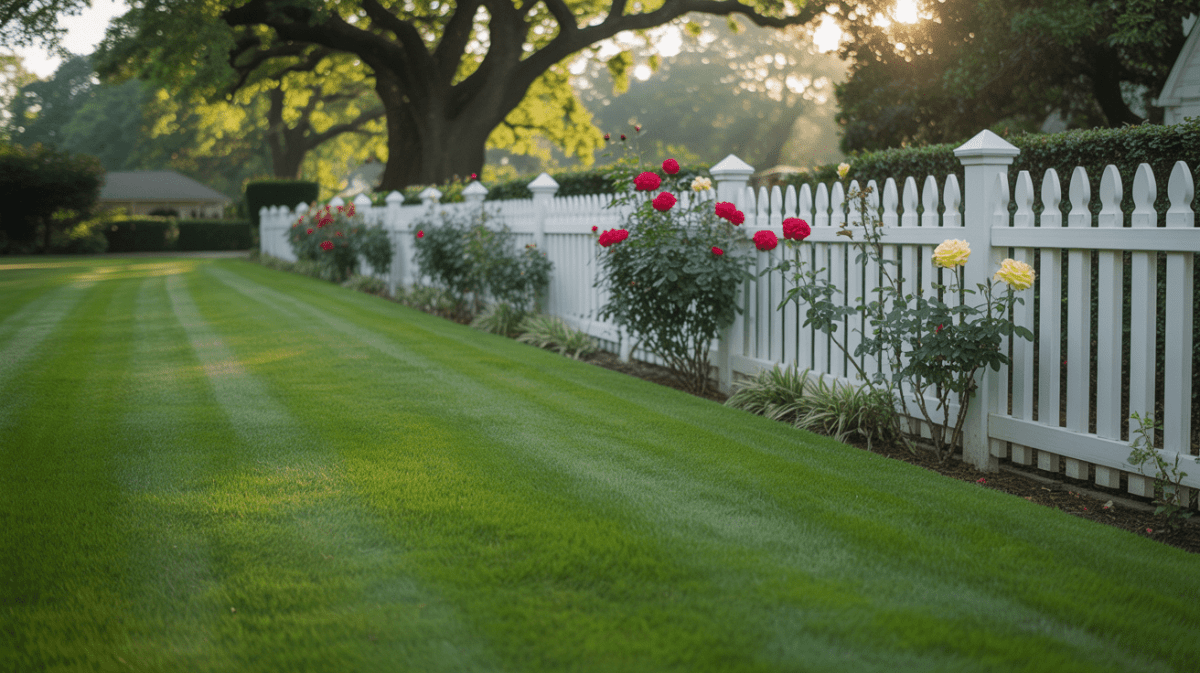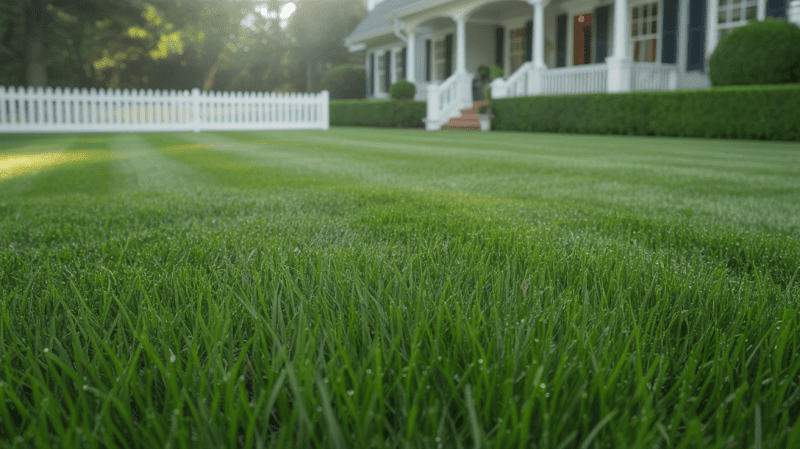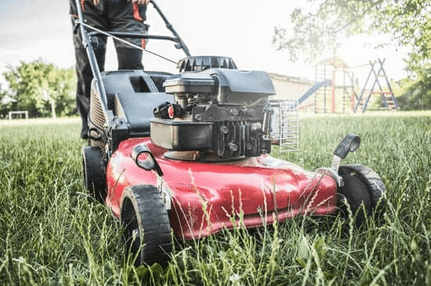Simple tips and tricks for a vibrant backyard oasis:
A beautiful, lush green lawn is every homeowner's dream. It's not just about looks; it also boosts your home's value and makes outdoor activities safer.
Proper lawn care is key to a perfect lawn. It includes soil preparation, choosing the right grass, and regular upkeep. With a step-by-step plan, you can turn your yard into a lively, healthy space.

A step-by-step lawn care guide will walk you through the process. We'll share lawn maintenance tips and green lawn strategies to help you get the lawn of your dreams.
Key Takeaways
- Soil testing is crucial for determining the right fertilizers.
- Proper fertilization promotes healthy grass growth.
- Regular lawn maintenance is key to a lush green lawn.
- Choosing the right grass type is vital for your climate.
- Consistent watering and mowing practices are essential.
Understanding Your Lawn's Needs
Knowing what your lawn needs is key to good lawn care. It's about looking at many factors that affect your lawn's health and look.
Assessing Your Soil Type and Quality
Checking your soil type and quality is very important. It tells you what nutrients your lawn needs. You can do a simple soil test to find out your soil's pH level and what it lacks. This info helps you pick the right fertilizer and soil amendments.
Identifying Your Climate Zone in the US
Identifying your climate zone is crucial for selecting the right grass and providing proper care. The US has different climate zones, from cool and temperate to hot and humid. Knowing your zone helps you predict the weather and plan your lawn care.
| Climate Zone | Characteristics | Recommended Grass Types |
|---|---|---|
| Cool-Season | Temperate climates with cold winters | Kentucky Bluegrass, Perennial Ryegrass |
| Warm-Season | Hot and humid climates | Bermudagrass, Zoysiagrass |
| Transition Zone | Mix of cool and warm seasons | Tall Fescue, Buffalograss |
Setting Realistic Goals for Your Lawn
Setting achievable goals for your lawn is important. It depends on your soil type, climate zone, and lawn's current state. Whether you dream of a lush green lawn or a simple, easy-to-care-for landscape, clear goals help you make the right choices.
Preparing Your Soil for Success
To grow a thriving lawn, it's essential to prepare your soil properly. This foundational step ensures that your grass receives the necessary nutrients to grow healthy and strong.
Conducting a Simple Soil Test
The first step in preparing your soil is to conduct a simple soil test. This test will help determine your soil's pH level and nutrient content. You can purchase a soil testing kit or consult a local nursery for assistance. The results will guide you in making the necessary adjustments to create an optimal growing environment for your lawn.
Adjusting Soil pH for Optimal Growth
Based on your soil test results, you may need to adjust your soil's pH level. Most grass types prefer a slightly acidic to neutral soil pH, between 6.0 and 7.0. If your soil is too acidic or alkaline, you can add lime to raise the pH or sulfur to lower it. Adjusting your soil's pH is crucial for nutrient availability and uptake.
Adding Organic Matter and Nutrients
Adding organic matter such as compost or well-rotted manure can significantly improve your soil's structure and fertility. This addition helps retain moisture, suppresses weeds, and provides a slow release of nutrients. Applying the right fertilizers based on your soil test recommendations can also provide your lawn with the necessary nutrients for healthy growth.
| Soil Type | pH Adjustment | Organic Matter |
|---|---|---|
| Acidic | Add Lime | Compost |
| Alkaline | Add Sulfur | Well-rotted Manure |
| Neutral | Maintain pH | Compost or Manure |
By following these steps, you can create a fertile and balanced soil environment that supports the growth of a lush, green lawn.
Selecting the Right Grass Type
The grass type you choose greatly affects your lawn's health and appearance. There are many options, so knowing the differences is key to making a good choice.
Cool-Season vs. Warm-Season Grasses
Cool-season grasses thrive in cooler weather, primarily found in the northern U.S. They grow best in spring and fall. Examples include Kentucky bluegrass and perennial ryegrass.
On the other hand, warm-season grasses love warmer climates, which are common in the south. They grow most in the summer. Popular varieties include Bermudagrass and zoysiagrass.

Popular Grass Varieties for American Regions
Different parts of the U.S. prefer different grass types because of the climate. For example, tall fescue is popular in the transition zone, where temperatures are moderate. In the south, where it's hotter, warm-season grasses like Bermudagrass are more common.
When and How to Plant New Grass
When to plant new grass depends on the type. Cool-season grasses do best in early fall or spring. Warm-season grasses thrive when planted in late spring to early summer.
Make sure the soil is ready and use the right seeding or sodding methods for the best results.
How to Achieve a Lush Green Lawn: A Step-by-Step Guide
To get a lush green lawn, you need to water, fertilize, mow, and aerate right. Follow these steps to make your lawn beautiful and healthy. It will make your outdoor space even better.
Creating an Effective Watering Schedule
Having a good watering schedule is key for a healthy lawn. Water deeply but not too often to help roots grow deep. This also cuts down on evaporation and runoff.
Fertilization Timing and Techniques
Fertilization timing is very important for lawn care. Fertilize at the right time to give your lawn the nutrients it needs. Choose the right fertilizer and use it as directed for your lawn's specific needs.

Proper Mowing Practices for Healthy Growth
Mowing practices greatly affect your lawn's health and look. Keep the mowing height and frequency right to help your lawn grow well and keep weeds away.
Aerating and Dethatching Methods
Aerating your lawn means making small holes to improve drainage and reduce soil compaction. It also helps roots grow strong. Dethatching removes the thatch layer to let air, water, and nutrients reach your lawn better.
| Lawn Care Practice | Benefits | Frequency |
|---|---|---|
| Watering | Promotes healthy growth, reduces stress | 2-3 times a week |
| Fertilization | Provides essential nutrients, enhances color | 2-4 times a year |
| Mowing | Maintains appearance, promotes healthy growth | Weekly during growing season |
| Aerating | Improves soil drainage, reduces compaction | Once a year |
Combating Weeds and Pests
Keeping your lawn green is more than just watering and mowing. It also means fighting weeds and pests. These can harm your lawn, so it's key to know how to manage them.
Preventing Weeds Before They Start
To stop weeds before they grow, use pre-emergent herbicides. Also, keep your lawn healthy with good care. A thick, healthy lawn makes it hard for weeds to grow. Here are some ways to stop weeds:
- Apply pre-emergent herbicides in early spring to prevent crabgrass and other annual weeds.
- Maintain proper mowing and watering practices to promote a healthy lawn.
- Fertilize your lawn appropriately to ensure it receives necessary nutrients.
Identifying and Treating Common Lawn Pests
To fight pests like grubs and chinch bugs, know their life cycles and use the right treatments. Watch your lawn closely to catch pest problems early. This makes treatment more effective.
- Inspect your lawn regularly for signs of pests.
- Use insecticides designed for your pest problem.
- Keep your lawn healthy to avoid pest problems.
Eco-Friendly Control Methods
Eco-friendly ways to manage weeds and pests are safer for the environment. They can work well without harming nature.
- Try natural herbicides like vinegar or cornmeal for weeds.
- Help beneficial insects like ladybugs and lacewings, which eat pests.
- Use organic soil amendments to keep the ecosystem balanced.
Seasonal Lawn Maintenance Calendar
To keep your lawn healthy and vibrant, following a seasonal maintenance calendar is key. This guide will show you the essential tasks for each season. This way, your lawn will stay lush and green all year.
Spring Revival Techniques
In the spring, focus on reviving your lawn after winter. Aerating and fertilizing are crucial. Aerating lets air, water, and nutrients reach the roots. Fertilizing gives your lawn the nutrients it needs to grow.
Use a balanced fertilizer to help your lawn grow healthily.
Summer Heat Management
Managing heat stress is vital in the summer. Proper watering techniques are important. Water deeply but infrequently to encourage deep root growth.
Keep your mower at a higher setting. This shades the soil and reduces water loss.
Fall Preparation and Overseeding
In the fall, prepare your lawn for the next growing season. Overseeding is a key task. It fills in bare spots and thickens your lawn.
Apply a fall-specific fertilizer to promote root growth before winter.
Winter Protection Strategies
Winter care involves protecting your lawn from cold damage. Avoid walking on frozen lawns to prevent compacting the soil. Apply a winterizer fertilizer to help your lawn recover quickly in the spring.
Conclusion
A lush green lawn comes from careful planning and regular upkeep. It also needs a deep understanding of what your lawn needs. By following this guide, you can make your outdoor space beautiful. It will make your home look better and provide a peaceful place to relax.
To get a lush green lawn, use good watering, fertilizing, and mowing habits. Regular checks on your lawn care will keep it healthy and green all year. This way, your lawn will always look its best.
Choosing the right grass and keeping the soil healthy are key. With a consistent care routine, your lawn will become the envy of everyone. Start using these tips today and see your lawn turn into a beautiful outdoor space.
FAQ
What is the best way to determine my soil type and quality?
A simple soil test can show your soil's pH and nutrient levels. This helps you know its type and quality. You can buy a DIY kit or get a professional analysis for more details.
How often should I water my lawn, and what's the best time of day?
Water your lawn deeply but not too often to help roots grow deep. Water in the early morning to cut down on evaporation and prevent fungal diseases.
What are the benefits of aerating and dethatching my lawn?
Aerating and dethatching improve soil drainage and reduce thatch. They help your lawn grow healthy. Aerating makes holes for air, water, and nutrients. Dethatching removes dead grass and debris.
How do I choose the right grass type for my climate zone?
Knowing your climate zone is key to picking the right grass. Cool-season grasses like cooler temps, while warm-season grasses prefer warmer climates. Look up grass varieties that do well in your area.
What are some eco-friendly methods for controlling weeds and pests?
Use natural herbicides and beneficial insects to control weeds and pests. Keeping your lawn healthy through proper care is also eco-friendly. These methods are safer for the environment.
When is the best time to fertilize my lawn, and what type of fertilizer should I use?
Fertilizing timing and type depend on your grass and climate. Fertilize during the growing season with a balanced fertilizer. For specific advice, talk to a lawn care expert.
How can I prevent weeds from taking over my lawn?
Stop weeds before they start by using pre-emergent herbicides. Keep your lawn healthy with regular mowing, watering, and fertilizing. A dense lawn can outcompete weeds.
What are some common lawn pests, and how can I identify them?
Common pests include grubs, chinch bugs, and billbugs. Look for signs like discoloration or thinning to identify them. For treatment advice, consult a lawn care professional.
DISCLAIMER
This document is provided for general information purposes only and should not be relied upon as providing legal advice, technical, or specific operational guidance to the reader, whether as to the practices described in the document or the applicable legal requirements and regulations. Lawnfly.com expressly disclaims any responsibility for liability arising from or related to the use or misuse of any information in this document.



